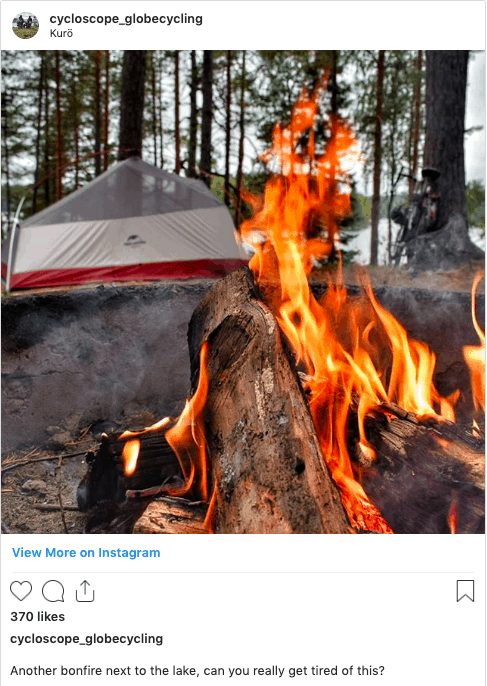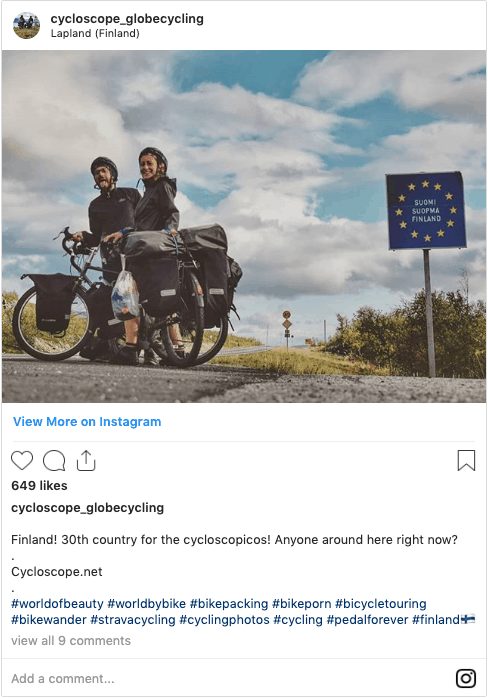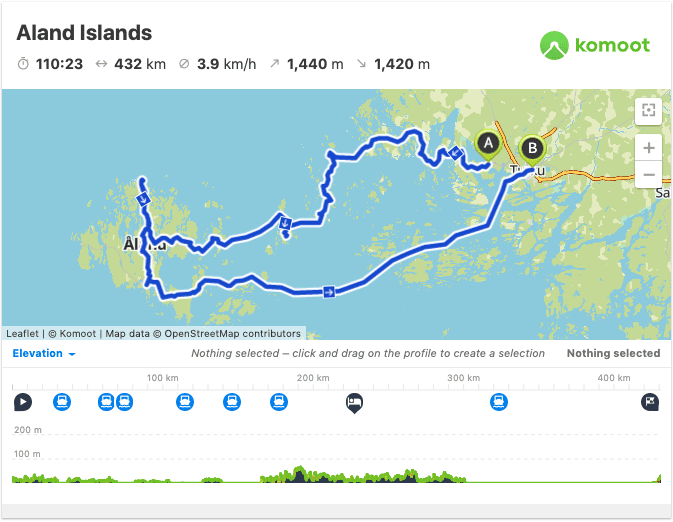Last Updated on 22 August 2024 by Cycloscope
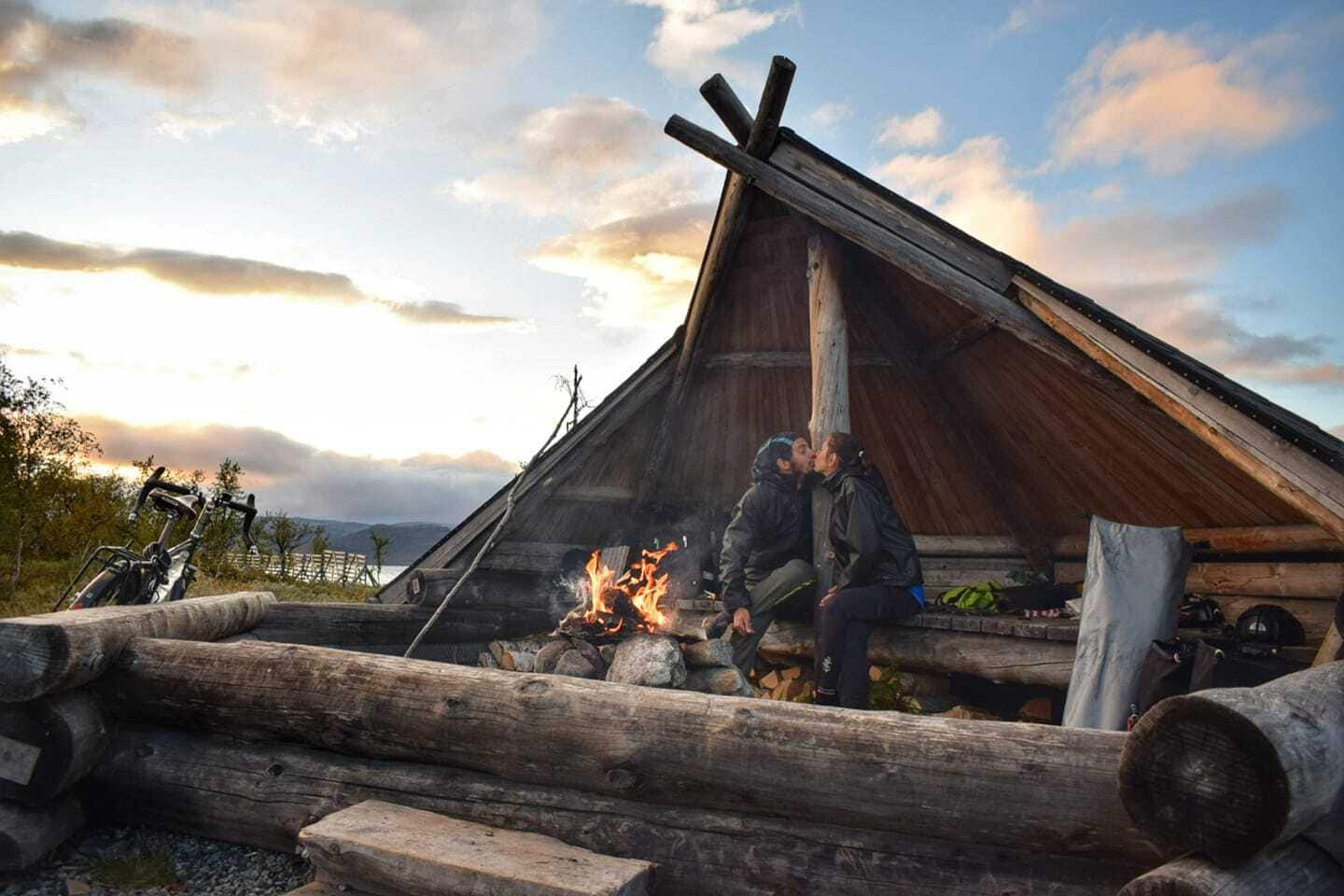
Finland by bike – The complete guide for bicycle touring and bikepacking. Complete with maps and GPS tracks of the best itineraries in Finland
Finland is a sparsely populated country, the forest covers 72.5% of its area, and dirt roads and tracks cut deep in the remoteness of these woods, making this country an ideal cycling destination for those looking to get lost in nature while having fun on gravel roads.
Finland can be a very easy destination for those who want to tackle a bike trip, naturally only if faced in the hottest season. First of all, Finland is flat, all of it, so you can grind many kilometers a day without too much effort, considering you do not get a headwind. The only hill found in the North, near the Norwegian border is Mount Halti, 1,324 meters high, the tallest peak in Finland.
Cycling in Finland in winter is, of course, a totally different matter. You will need to be more physically and technically prepared to face the harsh and long nights of the north.
Finland’s silence and wilderness will get deep into you, the uniqueness of the Lapland tundra has metaphysical powers over those with the right state of mind… don’t expect though a great variety of landscapes, cycling in Finland is more of a meditative trip, and to some it can be boring.
Planning to cycle in Northern Europe? Check also
The complete guide to traveling Norway by bicycle
The Wild Atlantic Way of Ireland… on a bike!
Cycling Poland: the best routes… not just EuroVelo
Climate in Finland
Finland, among the Scandinavian countries, is the one with the coldest temperatures. In general, the climate of Finland is characterized by a long and very cold winter and a short summer.
The good thing, at least for those who travel by bike, is that the rains are never very abundant (unlike Norway where it can rain seamlessly for weeks). Precipitations are concentrated mainly in the southern part of the country, especially in July and August and, a bit less, in autumn.
In winter, however, it snows very often, especially between February and April. Winter is very long and icy, about 5 months, from November to early April. The south of the country, where the capital Helsinki is located, is characterized by milder temperatures, but still around zero.
Going up north, as you approach Lapland, the temperatures drop more and more, even down to -50°. Here the winter is much longer and the hours of light are really very few, in December the sun never rises and, for the first weeks of January, there is only one hour of light during the day.
The lakes, which occupy a large part of the country, are often frozen during the winter and are used for various activities such as ice fishing or skating. Summer can take hot days with it, and for a short period, at the beginning of summer, there is a real invasion of mosquitoes that make cycling and camping in nature quite annoying.
In Summer, the days are very long and in the part of the country located above the polar circle, you can witness the magic phenomenon of the midnight sun in the months of June and July.
Finnish Lapland is also one of the best places for Northern Light tourism, you can see the Aurora Borealis above Rovaniemi for about 150 days per year, but you’ll have to wait for the colder seasons.
Best time to ride in Finland
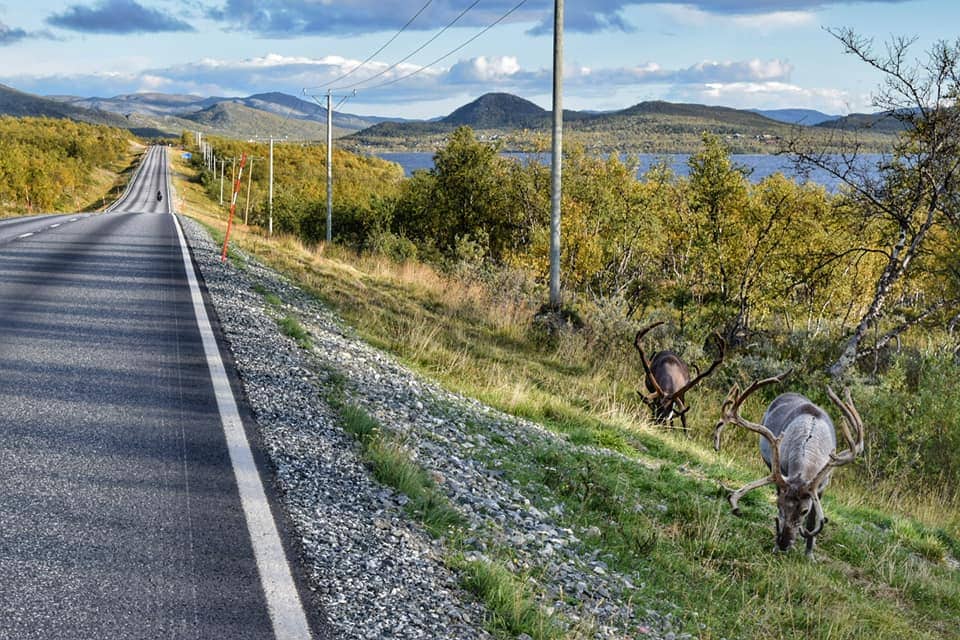
The best times are definitely late spring and mid/late summer, in May or mid-August/early September. In addition to the much more favorable climate, you will have long days… up to 20 hours of light are convenient if you want to travel many miles or stop to explore some areas better.
The beginning of summer, especially the first two weeks, is mozzies time. The density of blood-sucking-flying-bugs greatly varies according to the location, the more swampy/marshy the terrain and the less windy the weather, the more mosquitoes there will be.
In city centers, near big lakes or the sea, mosquitoes are almost non-existent, whereas at certain times during the summer in Lapland it’s a total inferno. Bring a good repellent and suitable headgear to keep them away if you plan to face the challenge. Winter is definitely a stunning time to visit Lapland, but maybe not on a bike/
Roads in Finland
Most of the main roads in Finland are perfectly paved, and traffic is never heavy, except in the coastal sections and some areas of the south that connect the main cities, such as Road 2 from Tampere to Helsinki or from Turku to Helsinki, the latter though has a dedicated cycling path all the way.
Cycle paths in Finland
Cycling in Finland is excellent, inhabited centers are equipped with cycle paths, and big cities like Helsinki are perfectly suited to bikes with marked itineraries and dedicated bicycle lanes.
The roads in the less inhabited areas, generally more to the north, do not need dedicated cycle paths, being mostly empty of cars.
The most interesting thing about Finnish roads is, however, the immense network of gravel roads cutting through the verdant pine forests. There are all sorts of those, from wide white roadways to single-track trails to snowmobile trails, you can travel the whole length of Finland staying on dirt for about 90% of the time… but it will take a while.
Those dirt roads are often the only way to get to the unnumbered lakeshores of Finland, major roads are indeed always built away from the water for weather and maintenance concerns. This is a pity, seeing that huge body of water near you only on a map, if you want to get there you’ll usually have to backtrack the same road.
Geography of Finland

Finland is located in the easternmost part of the Scandinavian peninsula, it borders with Russia to the east for about 1,268 km, to the north with Norway for 727km, and to the west with Sweden for 540km.
It has a very extensive coastline, over a thousand kilometers overlooking the Baltic Sea, where there are many islands. The emergence of the land following the melting of the ice from the last great glaciation is still underway, these lands are called in schären Finnish.
Apart from islands and archipelagos in the Baltic, the most famous and tourist being Åland islands near Turku, there are also many islands within the lakes, for a total of almost 180,000 islands.
The same impressive number is that of lakes (to be precise 187.888), all not very deep, which make up 10% of the surface of Finland.
As already mentioned, most of Finland is flat except for some hills in the northernmost part of Lapland and, still in the north, on the border with Norway, where the highest mountain in the country is located, Mount Halti at 1329 meters.
The tundra biome is present in a small area of Finland, its northernmost fringes in the sub-regions of Enontekiö, Utsjoki, and Northern Inari.
Vegetation in Finland
Although it may not seem at a glance, the flora of Finland is very diverse. 70% of the territory is covered by forests, in the north they are made up of birch trees, the only tree that can grow in the polar circle, while going southwards will appear to be conifers, poplars, maples, and elms.
The tundra is a very special landscape, with its small, contorted, witchy birches allowing the sight to gaze far away horizons.
But the marvel is below, the undergrowth is characterized by an enormous variety of mosses and more than 1,000 species of lichens.
Where to sleep in Finland
During the summer, you can collect many fruits in the woods, such as blueberries and raspberries, and only in Lapland, the camemoro, an orange forest fruit that only grows here… and guess what? You’re allowed to pick as much as you want.
Wild camping in Finland – The “right to roam” and the laavu philosophy
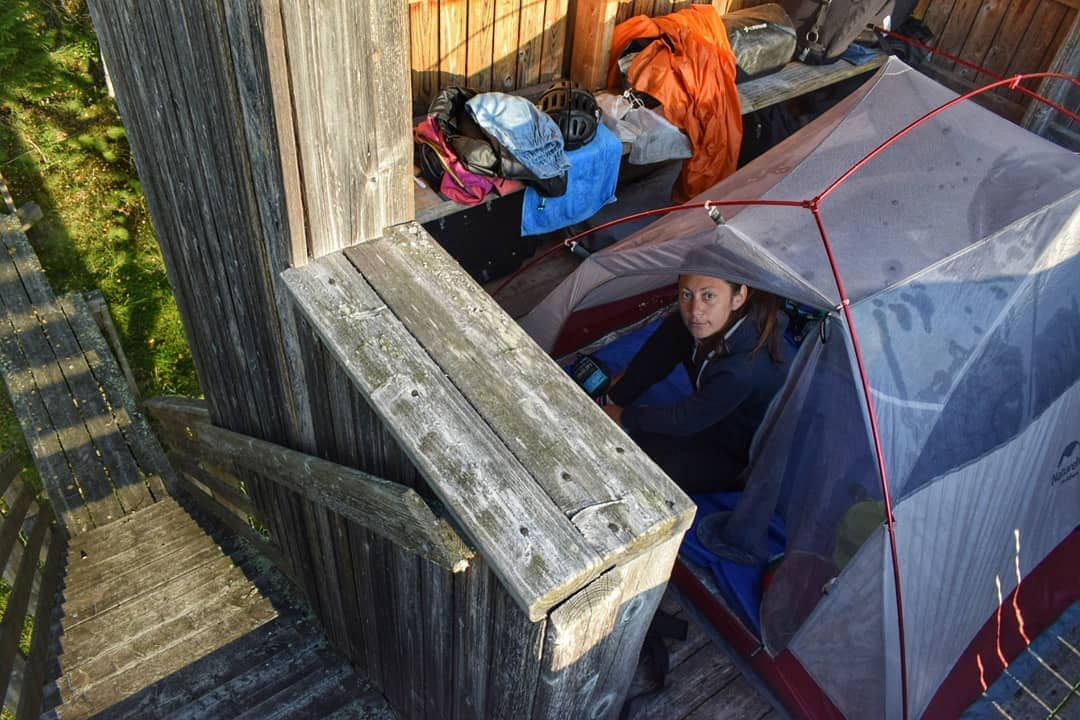
As in the other Scandinavian countries, Finland has the so-called Right to Roam, (also known as Everyman’s Rights) this is a law that grants everyone the freedom to enjoy forests, lakes, fields, and parks everywhere in Finland completely for free.
Unlike Norway, where there are many more rules and restrictions (you can read our article here), in Finland the situation is much more relaxed.
You can basically camp anywhere, except obviously in cultivated fields, adopting the logical rules of common sense and respect for the surrounding nature. If you find yourself on private property you must ask for permission to light a fire or collect wood.
As for the rule of passage, it is very simple: you can walk and ride a bike where you please, regardless of who owns the land, as long as you don’t cause any damage.
In Finland, you can walk, cycle and ski anywhere you want, from forests to fields (not cultivated of course), from beaches to private roads. It is only forbidden to go to areas where birds are nesting or any other zone where you could cause any kind of significant damage to nature.
You can collect all the berries and mushrooms you want. In Finland, there are about 500 edible species of mushrooms growing in forests, of which 200 are excellent to eat. However, nature can be cruel and some varieties, apparently similar to good ones, are instead poisonous.
So make sure you only choose the mushrooms you know, there are also apps that can help you identify. The Finns used to say “You can eat any mushrooms you want, but some of them you can eat only once”. It is also allowed to resell what you have collected without having to pay any tax, we will discuss it better in the next paragraph.
The best places for camping in Finland: Laavu, Kota, Lintutorni, and other shelters
If pitching your tent wherever you want is not enough, Finland also has a dense network of shelters of various types. Here you can sleep and spend time for free, they often have a place to make fire and are stocked with firewood. Here you can find the map of shelters in Finland: www.tulikartta.fi.
Unfortunately, it is only in Finnish but it is not difficult to use, you can zoom in the area you are interested in and see what is there, or filter by type of shelter. By clicking on Tulipaikat you will be able to filter by type of refuge, to help you navigate it here is the description of the various structures:
- Laavu; is a wooden hut open on one side. If you have a small tent you can mount it inside otherwise you can sleep with just the sleeping bag if it is not too cold. there is always wood to light the fire (sometimes even the newspaper for starters), and the grill to cook on the brace. Most laavu are placed next to a compost toilet and always close to somebody of freshwater, we also found rudimentary fishing rods (what you see in the cover image of this article is another type of laavu)
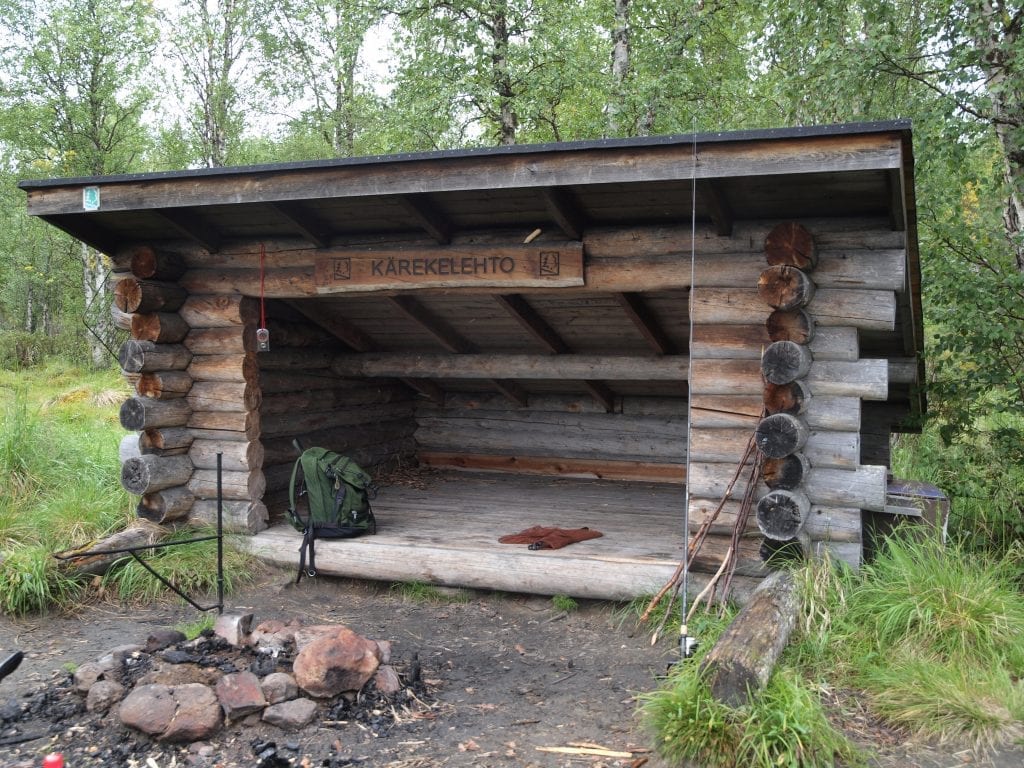
- Kota is the Lappish hut. This version is made of wood, closed on all sides, accessible by a door. In the middle, there is the brazier, and here too you’ll find firewood, a grill, and everything you need to warm up – definitely better than a TV stand with a fireplace ain’t it?
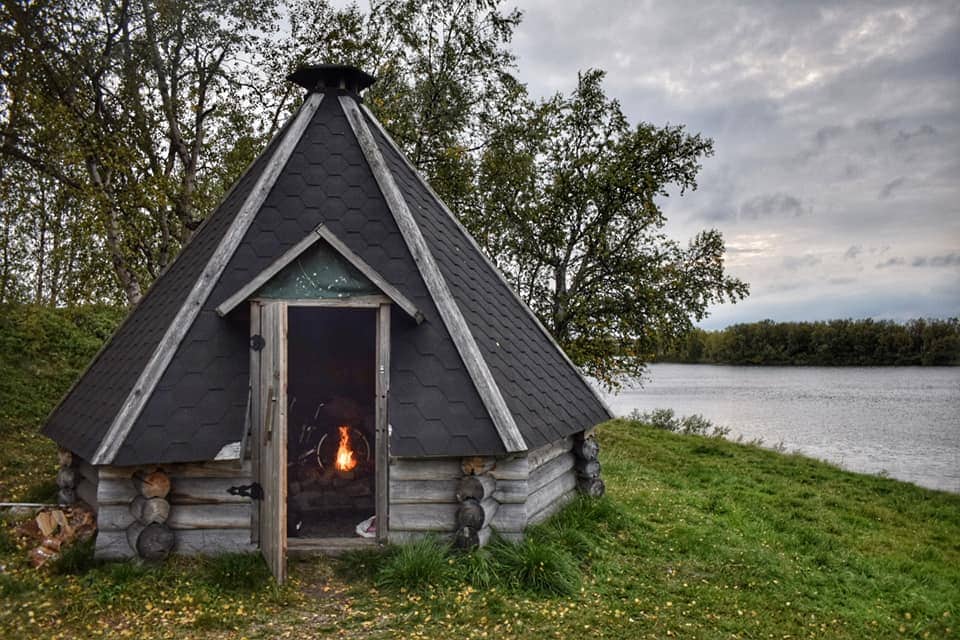
- Lintutorni, is a birdwatching tower. You can mount the tent on the wooden platform at night. Some have a roof and some don’t. It is not possible to light fires here.
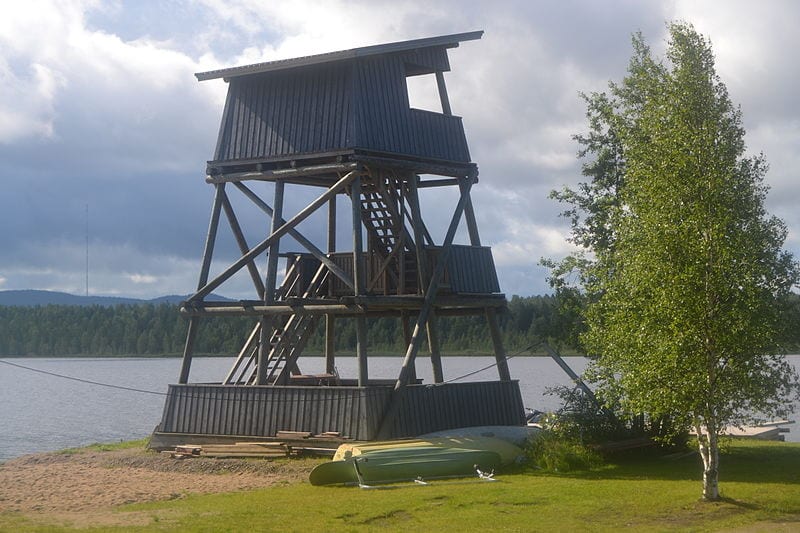
- Varaustupa, Porokamppa, and Autiotupa; these three types of shelters are proper houses. They are usually found along paths and trails, far from the main roads. Some are open (especially those most remote ones), while for others you’ll have to ask for the keys to the local forestry office. There are free ones, basic but almost luxurious for a bike traveler, and cozier ones which require a fee. Usually, for a varaustupa you need to reserve and retrieve the keys. They are all equipped with heating, usually a fireplace or wood stove, but you have to bring your own sleeping bags.

- Kammi, from what we understand these are saunas but we have never met any. We don’t believe it is possible to sleep inside them and we don’t know if they are open or if it is necessary to ask someone for the keys. By asking someone in the area it shouldn’t be difficult to have this information, the Finns know everything about saunas.
- Ruokailukato, literally translated into dining canopy, is a wooden shelter with a roof but with 4 open sides, equipped with a table for eating. Usually not large enough to set up a tent but often located near a compost toilet. Still a good place to set your camp.
Back to Tulikartta.fi, by clicking on Maakunnat you can select the geographical area you are interested in, but for us, traveling by bike, it was more convenient to search by zooming in on the area where we were, however, it is easy, we found a shelter every evening.
Not all shelters are on the map, which is open street and was born thanks to user contributions. Clicking on Lisaa, in fact, you can add a shelter if you happen to find one not yet reported.
Paid campsites in Finland
In Finland equipped camps are quite common and cost less than in Norway, almost all campsites have cabins, or bungalows, which is also the cheapest form of accommodation here. They are particularly convenient when traveling in groups of three, four, or more people since most of the cabins have four to six bunk beds, and you always have to pay for the whole cabin.
The price of camping cabins is variable, we paid the cheapest 20€ but average prices are around 30, also depends on the season, if there are northern lights costs rise.
Most campsites have basic cabins with shared toilets and a kitchen, although basic cooking gear (rarely running water) is often present in the cabin itself. Most of these campsites are open all year round, the cheaper cabins usually have electric radiators, while the higher-end ones may even have a fireplace and a private sauna.
The campsites in Finland are mostly small and cozy, there is always a shared kitchen and often a closed hut for barbecue, equipped with all the necessary and accessible to all guests. Showers are included, washing machines and dryers are available for a fee, and the price for a tent in a Finnish campsite goes from 10€ upwards.
Hotels and Hostels in Finland
Hotels are quite expensive in Finland, but you can find rooms in the city for around €50, even in Helsinki.
The hostels are only in the main cities or tourist towns, with an average cost of 19€ per person per night in a dormitory. All these prices are variable depending on the season. This is the cheapest hostel in Helsinki, it has both dorms and private rooms.
Here are the best accommodation offers in Turku, a very beautiful city not to be missed if you visit the south of Finland and the Åland archipelago.
Couchsurfing and Warmshowers in Finland
Not a huge community but very active and welcoming, even beyond what could expect. We have always been accepted (we only tried Warmshowers), and they offered us saunas, beautiful warm rooms, food, and once even a ride in the car, insisting that Finland can be very boring…
For those who do not know what Warmshowers and Couchsurfing are, take a look here.
Costs of a cycling trip in Finland
Finland, needless to say, is an expensive country although not as much as one might imagine, at least compared to central Europe.
The prices of the hotels are more or less the same as in Italy, the supermarkets are more expensive than in Germany but not exaggerated, about half those of Norway with twice the choice. Choosing carefully what to buy you can still spend little.
We have never been to a restaurant but we have seen prices very similar to those of Italy. Only once did we eat sushi all-you-can-eat in Helsinki for lunch, which cost 10€. In the big cities, there are plenty of cheap sushi places as well as many other ethnic restaurants.
How to earn some pocket money while cycling Finland
For those who are traveling on a budget like ours (very tight), Finland offers several possibilities to gather a little cash while riding through the country.
One of these, suggested by the Finnish tourism website, is to sell wild berries and mushrooms collected in the forests, especially in summer the typical berries of Lapland are sold at rather high prices in the rest of Finland. Be careful not to kill anyone.
Since we were not very acknowledged of mushrooms and were late for the berries we adopted another technique, collecting cans along the roads. Despite the stereotype of the respectful and civilized Scandinavian, the cans thrown by cars along the roads are many.
In every food store in the country, small or large, there is a machine where you can insert the cans, paid 0.15 cents each, and the plastic bottles (from 0.10 to 0.40 cents each, depending on the size). After inserting cans and bottles just press the green button and the machine will output a receipt with the total amount. You can use it in the shop to buy stuff or ask to be given cash in hand.
We hung a bag on the front rack and earned a couple of euros per day for shopping, while also helping to clean the streets a bit!
Another idea is to ask the supermarkets for the expiring food that they are about to throw away, they will be happy to give it to you. Help reduce food waste, it’s free! You will have to go to the supermarkets near the closing time though.
If instead, you are more akin to traditional methods, one of the favorite pastimes of the Finns is fishing. In Finland, it is allowed to fish using a simple fishing rod with hook and line wherever you want, without a separate license or authorization. However, any other type of fishing requires a permit.
What to bring for a bike trip to Finland
Unless you have a very big budget, or you’re going for a short cycling holiday, you’ll have to be totally self-supported in order to cut down on the big accommodation and food costs.
Bring complete camping gear, 4 season tent is a plus while a 2°/0°C comfort sleeping bag is a must even in Summer. You won’t regret a thick and high R-rated sleeping pad, consider also linens. Bring a stove and pots, standard gas canisters are widely available.
Clothing should include base layers, merino wool sleeping clothes, leg warmers or long pants (better both), hardshell jackets and Windstopper (softshell), warm gloves, ear-covering wool hat; we also used a thin but warm down jacket we were glad to have while cooking in the evening.
All of the above is for summer (late spring/early autumn), things can get chilly even during daytime, especially at higher latitudes or altitudes. We will cover winter clothing in an upcoming article.
Rain gear is what makes the difference between a miserable day and a very-very-miserable day. Succeeding in having at least the more hidden parts of your body dry after an all-out rainy day should be your aim. We used Naturehike long poncho on a waterproof jacket, rain pants, and shoe cover.
Don’t make the mistake of visiting Finland without a decent camera, those marvels are worth memories.
Cycling Finland – Map and GPX track of our route
The one above is the map of our itinerary in Finland
Choosing a bike route – Cycling itineraries in Finland
Finland is a very long country and could become quite boring due to the long tracts of monotonous landscape.
We crossed it mostly by bike, but we also took a train to speed things up. If you’re not on a North Cape trip, you can choose shorter routes. Above is our itinerary in Finland in its entirety, and below are some shorter routes.
Åland Island – 432km (193km are ferries)
The Åland archipelago is the ideal destination for a cycling holiday: a beautiful landscape, flat roads with no traffic, and excellent connections between the islands with bridges and ferries, at least during the summer. These islands are located in the Baltic Sea, west of Turku, between Finland and Sweden.
The maximum altitude of the islands that make up the archipelago is 130 meters so it can be faced by anyone, without the need for any particular training. Only 65 out of 6500 islands are inhabited.
There are several ferries that make regular trips between the islands: check timetables before embarking on your trip by bike, some islands are served by a few ferries and some routes are not active all year round but only during the summer.
From Turku you can reach by a cycle path the town of Naantali, called the “city of the sun”, with a very nice port and a historical center worth a visit, from here you can continue towards Kustavi where there is a craft village.
Continuing towards the Brändö islands, you’ll arrive by ferry on the main island of Åland. It is possible to cycle on the ancient postal road and reach the ruins area of Bomarsund.
The fortress of Bomarsund, built by the Russian army and destroyed by the French and English during the Crimean War, was once the largest structure of the Åland Islands. From the village of Kastelholm, where there is a castle, you can continue to Havsvidden, the northernmost tip of the island, characterized by red granite rocks.
About 50 kilometers from Havsvidden is Mariehamn, the capital of the Åland Islands, where there are a couple of museums to visit. Mariehamn is the one “big” center in the islands where to stop if you are looking for groceries and supplies. It is also the only place where you can rent a bike, prices start at 35€ per week.
Near Mariehamn, there is the port of Turk from where there are direct sea connections to Turku, probably the most beautiful city in Finland. From Mariehamn, you can also reach Stockholm by ferry.
As for your accommodation, you can choose between campsites, cottages, bed & breakfasts and rooms made available by individuals in their homes. It is advisable to book early, especially for the high season of June and July. Get inspired by some Aland Islands pictures here.
Check Pictures and Reviews on TripAdvisor
Map and GPS track of the Aland Islands cycle trail
Saimaa and the region of a thousand lakes
Finland is full of cycling trails, official and not, there are many dirt roads through the forests that are worth trying, but better be equipped with a good GPS.
The lake region in Finland covers 10% of the country’s territory so you can really create an itinerary depending on how much time you have and how many kilometers you want to travel.
This region is also ideal for canoeing, and a great destination for bikerafting (cycling and pack rafting loading the bike on an inflatable boat). Here we will talk about Lake Saimaa, in the southern Karelia region, a place full of cycling routes.
A very popular route goes around Lake Saimaa, the largest in Finland. Starting from Lappeenranta you’ll cross several bridges and hop on many small islands. The lake is very picturesque, with steamboats still operating.
One kilometer from Toijansalmi is the Hostel Mansikka, well known among cyclists. Here you will find great food, drinks, and the impeccable service of the Belgian owner to welcome you.
Other points of interest along the way are
- Vehkataipale – here you will find the hydroelectric power station and the locks that allow boats to pass from Lake Pien-Saimaa to Suur-Saimaa and vice versa. The locks are still manually operated.
- the Kirjamoinsalmi Bridge (11 meters) – the beach of Kivisalmi and its rocks await you for a well-deserved break on the border between Lappeenranta and Taipalsaari. From the road, you will enjoy a magnificent view of Lake Pien-Saimaa.
- Toijansalmi, where a 23-meter high bridge offers a spectacular 360° view of the lake. There is also a nearby beach where you can swim, temperature permitting.
The cycle route from the Taipalsaari Bridge to Lappeenranta is one of the most scenic stretches of Finland, at any time of the year.
Check Pictures and Reviews on TripAdvisor
Our route in Lapland
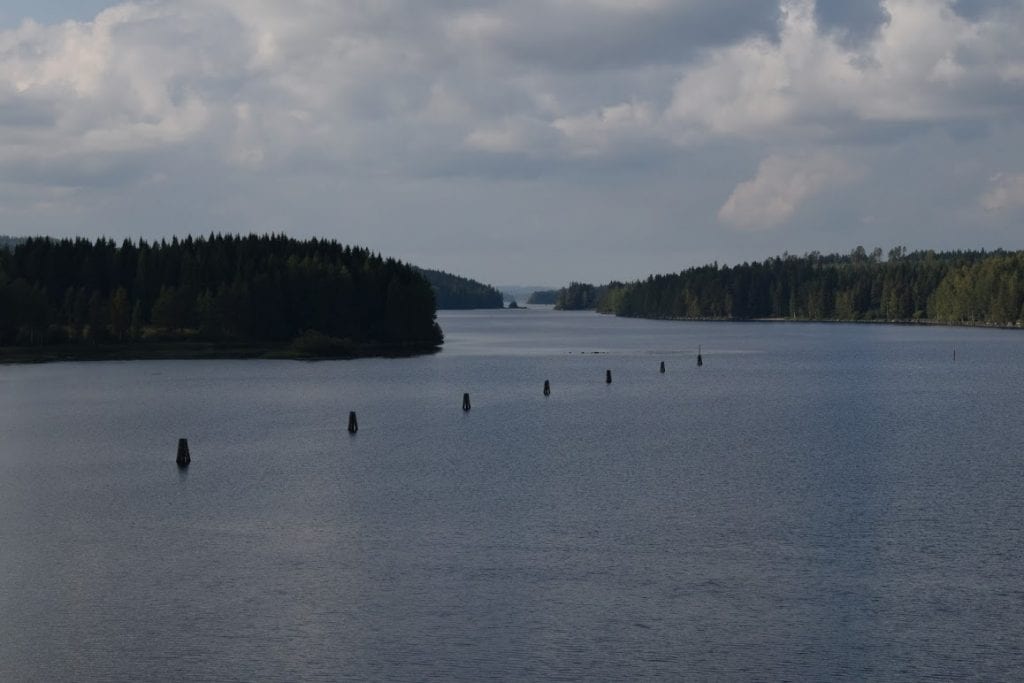
On our bicycle trip around Europe, we entered Finland from the Norwegian border – near Kilpisjärvi – and continued along the E8 national road, which follows the Swedish border, along the Peerasuvantu River.
We must say that coming from the magnificent landscapes of the Norwegian fjords we did not expect anything exceptional from Lapland but instead, we were gladly surprised by the almost alien landscape of northern Finland.
This hilly border area is surrounded by a neverending birch forest, the only trees able to survive such a high latitude and far from the sea.
This is the tundra, where small contorted birches are the only trees, while endless varieties of mosses and lichens thrive in the underwood and reindeer graze freely (you will see dozens of times along the way).
After passing the hilly area and descending into a sort of marshy/swampy area, the woods begin to be inhabited by conifers, deer, and elk. This is around the 68th parallel latitude – near the town of Muonio.
From Muonio it began a bit monotonous, going on to the most urbanized and less alien landscape to the capital of Lapland, Rovaniemi, where there is the super-commercial village of Santa Claus. There are many things to do in Rovaniemi in Autumn, worth using it as a base to explore.
Lapland alone is a sufficient reason to visit Finland, this is our favorite part of the country.
Here you can see and download the route map: Cycle Route Keminmaa – Kilpisjärvi
Check Pictures, Things to Do and Accommodation in Rovaniemi
Out of Finland – Helsinki and the Love Boat

Helsinki is certainly a nice city to explore, if you haven’t had a Finnish sauna yet you should definitely visit the Sompasauna, the best public sauna in Finland. We didn’t spend much time in the capital though, rushing a bit to take the boat to Estonia we left all the nice things to do in Helsinki for another time.
Cycling into Helsinki, however, is a piece of cake. With perfect and quiet cycling paths that go from the outskirts all the way to the city center.
To get out of Finland, unless you have a Russian visa, the only way is to take a ferry. There are several routes in the Baltic Sea, the most popular being the ship connecting Helsinki to Stockholm. The runs are daily and operated by Viking Line and Tallink Silja.
Instead, we took the ferry Helsinki-Tallinn (Estonia), a route that could be done in two hours, but if you want to spend less (yes) you can sleep on the ship moored at the port of Tallinn and leave quietly by noon of the following day.
If you wonder why sleeping on the ship is cheaper than getting off once you get there, the answer is simple: Booze! The ship, in fact, has several bars with live music, a nightclub, and numerous restaurants.
If you are not interested in drinking at the bar or buying liquor at the tax-free shop, you will still have saved the cost of a night at the hostel in Tallinn. We had a lot of fun and we only paid €17 in total for a two-person cabin, our bikes went free)… although once we got off we had to find a hostel in Tallinn to recover from the hangover 🙂 There are various last minute offers and prices vary depending on the season. Check the Ferry Schedule and Price Finland is certainly not famous for its food, but that is actually not bad at all, in the cities there are many foreign and local restaurants at reasonable prices (for Northern European standards). Probably, during a long bike trip, you will not visit many of them unless you have a high budget. For those who like to provide for themselves, supermarkets are quite supplied they have more choices than in Norway and prices are lower. Finland is also the only Scandinavian country where alcohol consumption is not strictly regulated, you’ll find bars also in the small villages and it’s possible to buy beer from supermarkets with no restriction. For us, who arrived from expensive Norway, seeing the first Lidl gave us a sigh of relief. You can find these German discount supermarkets in the main cities and villages of medium size. Other convenience store chains in Finland are Alepa, K-Market, R-kioski… while normal supermarkets are K-Citymarket, Prisma (the most stocked), and S-Market. Keep in mind that in the less inhabited areas of the country, such as Lapland, there may also be 90 kilometers between a supermarket and the other, so when you encounter one it is best to stock for at least a couple of days. Furthermore, many close very early, around 6 pm, and are closed on Sundays. As in other Scandinavian countries, alcohol consumption in Finland is highly regulated, albeit much less than in Sweden and Norway. The monopoly of the sale of alcohol above 5.5% and up to a maximum of 22% is held by Alko, so if you want to buy something that is not beer you have to go to one of their stores; they are located in major cities and are not always open. However, beer up to 5.5% can be bought in supermarkets until 9 pm. There may be different opening times during the weekend but we do not remember them. The bars and restaurants can serve alcohol until 1:30 am. Riding in Lapland we have seen many empty bottles with Russian labels, perhaps there is a sort of black market in the border areas. In any case, we met a lot of drunk people. Tap water is very good in Finland. In Lapland, people also drank from rivers and lakes, but when we were there summer was warmer than expected and locals advised against drinking because of the possible presence of proliferated bacteria due to the high temperatures. Planning to cycle in Northern Europe? Check also Did you find it useful? Do you have more information or advice about Finland? Share, comment, and follow up on social networks!Food and drinks in Finland
Supermarkets in Finland
Drinking Alcohol in Finland
Water
The complete guide to travel to Norway by bicycle
The Wild Atlantic Way of Ireland… on a bike! – Cycling Poland: the best routes… not just EuroVelo


